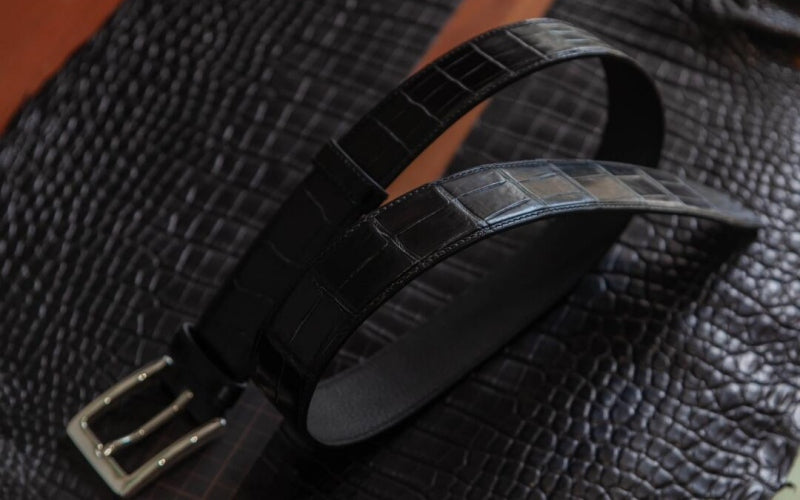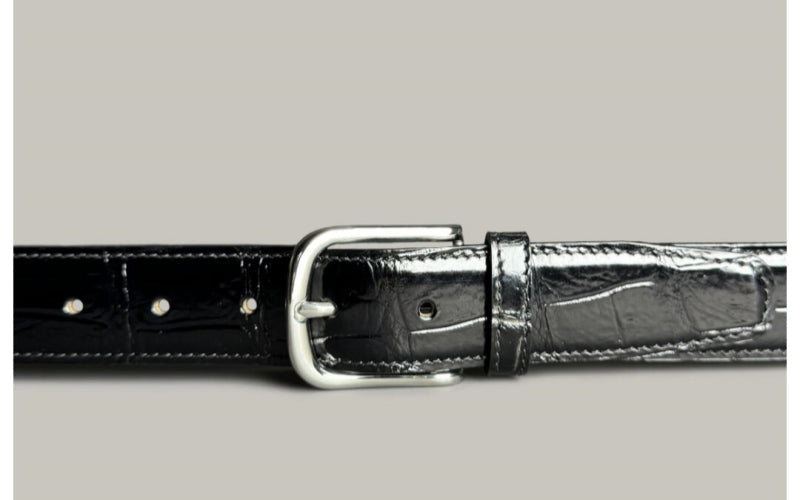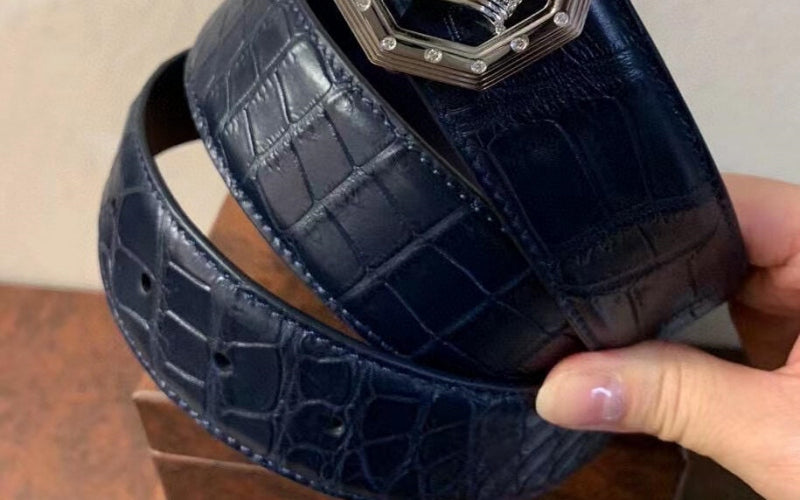
Why Is Alligator Leather So Expensive?(8 Reasons Explained By BELTLEY)
Let’s be real: Alligator leather is the Beyoncé of fashion materials—luxurious, iconic, and painfully expensive. You’ve seen those glossy belts priced like they’re made of unicorn hide, and you’re left wondering, “Why does dead reptile cost more than my rent?”
As someone who’s toured alligator farms, interviewed tanners, and accidentally ruined a $3,000 gator wallet with sunscreen (RIP, Gary), I’m here to spill the tea. Buckle up—this is part economics lesson, part swamp safari.
 Obsessed with this belt? Find its twins — tap the pic.
Obsessed with this belt? Find its twins — tap the pic.
Reason #1: Alligators Aren’t Cows (And Farming Them Is Wildly Complicated)
The Cold Hard Facts:
-
Geographic Limits: American alligators live in five U.S. states. Compare that to cows, which graze on six continents.
-
Slow Growers: Gators take 3–4 years to reach harvest size. Cows? Slaughtered at 18 months.
-
CITES Quotas: The Convention on International Trade in Endangered Species caps how many gators can be farmed yearly. In 2023, Louisiana (the gator capital) was allowed just 280,000 wild eggs for farming.
Why It Matters: Limited supply + slow growth = prices that’ll make you gasp louder than a tourist spotting their first gator.
Fun Analogy: Farming alligators is like raising a rare orchid in a desert. Possible? Yes. Profitable? Only if you’re really patient.

Reason #2: Gator Farms Are Basically Five-Star Resorts (For Reptiles)
Spoiled Gator Alert:
-
Habitat Costs: Farms need temperature-controlled pools, UV lighting, and vet care. One farm in Florida spends $500,000/year on electricity alone.
-
Diet: Gators eat premium feed (fish, vitamins, and the occasional unlucky chicken). Annual food cost per gator? $200.
-
Labor: Farmhands risk losing fingers to monitor gator health. Hazard pay? You bet.
Beltley’s Take: Our sustainable cowhide belts skip the drama—no VIP gators, just honest craftsmanship.

Reason #3: Tanning Gator Hide Is a Science (And an Art)
From Swamp to Shelf:
-
Salting: Hides are packed in salt for weeks to prevent rot.
-
Pickling: Soaked in sulfuric acid (yes, really) to soften scales.
-
Chrome Tanning: Uses chromium sulfate for durability. Costs $50–$100/hide.
-
Hand-Staining: Artisans dye each scale individually. Time per hide? 8–10 hours.
Pro Tip: Cheaper brands use machine pressing to fake the scale texture. Real gator leather? Each scale is a unique little snowflake.

Reason #4: The “Belly Cut” Obsession (And Other Aesthetic Demands)
What Buyers Want:
-
Prime Cuts: The soft, pebbled belly leather is most coveted. Only 40% of a gator’s hide qualifies.
-
Flawless Scales: Blemishes from fights or parasites can trash a hide’s value. Rejection rate? 30%.
-
Color Consistency: Dyeing uneven scales without patches requires Michelin-star-level skill.
Translation: You’re paying for perfection. And Mother Nature hates perfection.
 Obsessed with this belt? Find its twins — tap the pic.
Obsessed with this belt? Find its twins — tap the pic.
Reason #5: Regulations Cost More Than a Lobster Dinner
The Legal Jungle:
-
CITES Permits: Exporting gator leather requires paperwork that’d bury a small office. Permit cost? $200–$1,000/hide.
-
Ethical Audits: Farms pay $10,000+/year for humane certifications.
-
Anti-Poaching Tech: GPS trackers, drones, and guards keep wild gators safe. Annual cost? $500,000+ for big farms.
Irony Alert: Protecting wild gators makes farmed ones pricier. Nature’s got jokes.
 Obsessed with this belt? Find its twins — tap the pic.
Obsessed with this belt? Find its twins — tap the pic.
Reason #6: Handcrafting = Labor of Love (And Bills)
Artisan Breakdown:
-
Scaling: Hand-sanding each scale to uniform thickness. Time: 2 hours.
-
Stitching: Saddle-stitching the edges to prevent fraying. Time: 3 hours.
-
Polishing: Buffing the buckle to a mirror shine. Time: 1 hour.
Total Labor Cost: $300–$500/belt. And that’s before the designer logo tax.
 Obsessed with this belt? Find its twins — tap the pic.
Obsessed with this belt? Find its twins — tap the pic.
Reason #7: Luxury Brands Are Master Markup Magicians
The Price Hike:
-
Brand Tax: A Hermès gator belt costs $5,000. The raw materials? Maybe $800.
-
Exclusivity: Limited editions and “bespoke” options inflate prices.
-
Celebrity Tax: If Jay-Z wears it, the price doubles. Basic math.
Beltley’s Secret: Our luxe cowhide belts offer similar quality for 1/10th the price. No celebrity tax, just craftsmanship.
 Obsessed with this belt? Find its twins — tap the pic.
Obsessed with this belt? Find its twins — tap the pic.
Reason #8: You’re Paying for Guilt (And Sustainability Theater)
The Ethical Surcharge:
-
Carbon Offsets: Some brands charge extra to “offset” farming emissions.
-
Habitat Conservation: Farms donate to wetland preservation. Cost passed to you? Obviously.
-
Vegan Backlash: Brands hike prices to offset lost sales from eco-conscious buyers.
Harsh Truth: You’re not just buying a belt—you’re funding a moral balancing act.
Bonus: How Alligator Leather Compares to Other Exotics
-
Crocodile: Rougher scales, higher durability. Price: 10–15% more than gator.
-
Ostrich: Softer, cheaper ($1,000–$2,500), but less “wow” factor.
-
Python: Edgy, fragile, and banned in California. Price: $800–$1,500.
The Ethics of Alligator Leather: A Tightrope Walk
Pros:
-
Byproduct Use: Most gators are farmed for meat; hides reduce waste.
-
Jobs: The industry employs 10,000+ people in Louisiana alone.
Cons:
-
Confinement Stress: PETA argues farms stress gators (they’re solitary in the wild).
-
Greenwashing: “Sustainable” claims are often… stretchy.
Beltley’s Stance: We stick to cowhide. But if you go gator, choose CITES-certified vintage.
How to Care for Your Gator Belt (So It Doesn’t Die)
-
Condition Monthly: Use reptile-specific balm. Avoid coconut oil—it’s for salads, not belts.
-
Store Flat: Rolling causes scales to crack like your phone screen.
-
Avoid: Heat, water, and your cat’s claws.
8 Reasons Recap: Why Your Bank Account Is Crying
-
Rare AF gators.
-
Farming costs = a small country’s GDP.
-
Tanning is a chemistry nightmare.
-
Only 40% of the hide is usable.
-
Regulations pile up like dirty laundry.
-
Handmade = $$$ labor.
-
Brands laugh all the way to the bank.
-
You’re paying for ethical mental gymnastics.
Final Verdict: Is It Worth It?
Yes if:
-
You’ve got disposable income and a tailored wardrobe.
-
You love artisanal craftsmanship (and bragging about it).
-
You’ve researched your source like it’s a Tinder date.
No if:
-
You’d rather feed a family for a year.
-
You think “quiet luxury” means not discussing your credit card debt.
-
Your dog eats shoes (RIP, $5k belt).
Still tempted? Check out Beltley’s Ethical Alternatives or drop a comment. Confess: Have you ever splurged on something absurd? We’ve all been there.

